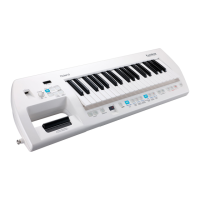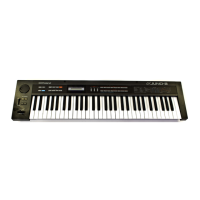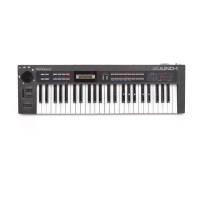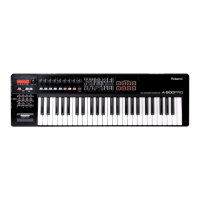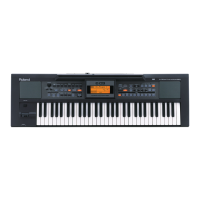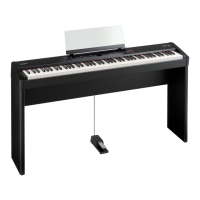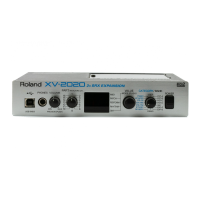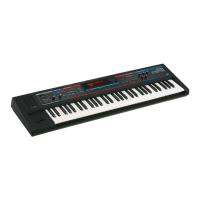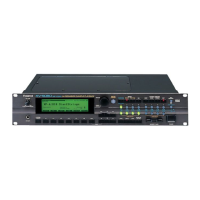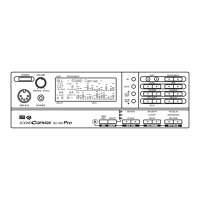MFX/IFX Parameters
69
73 SBF-325
(Flanger)
This effect reproduces Roland’s SBF-325 analog flanger. It provides
three types of flanging effect (which adds a metallic resonance to
the original sound) and a chorus-type effect.
L in L out
R outR in
Parameter Value Explanation
Mode
Types of flanging effect
FL1 A typical mono flanger
FL2
A stereo flanger that preserves the stereo
positioning of the original sound
FL3
A cross-mix flanger that produces a more
intense effect
CHO A chorus effect
Rate Sync
(Rate (sync switch))
OFF, ON
If this is ON, the rate synchronizes with
the tempo of the rhythm.
& “Tempo” (p. 8)
Rate Hz (Rate (Hz)) 0.02–5.00 [Hz]
Modulation frequency of the flanger
effect
Rate Note
(Rate (note))
Note
& “Note” (p. 72)
Depth 0–127 Modulation depth of the flanger effect
Manual 0–127
Center frequency at which the flanger
effect is applied
Feedback 0–127
Amount by which the flanging effect is
boosted
If Mode is CHO, this setting is ignored.
R Mod Phase
(CH-R Modulation Phase)
NORM, INV
Phase of the right channel modulation:
Typically, you will leave this at Normal
(NORM). If you specify Inverted (INV),
the modulation (upward/downward
movement) of the right channel is
inverted.
L Phase
(CH-L Phase)
Phase when mixing the flanging sound
with the original sound
NORM: normal phase
INV: inverse phase
R Phase
(CH-R Phase)
Level 0–127 Output Level
74 SDD-320
(DIMENSION D)
This models Roland’s DIMENSION D (SDD-320). It provides a clear
chorus sound.
L in L out
R outR in
Parameter Value Explanation
Mode
1, 2, 3, 4, 1+4, 2+4,
3+4
Switches the mode.
Low Gain -15–+15 [dB]
Amount of boost/cut for the low-
frequency range
High Gain -15–+15 [dB]
Amount of boost/cut for the high-
frequency range
Level 0–127 Output Level
75 2TAP PAN DELAY
R out
L out
Balance W
Balance W
Balance D
Balance D
L in
Double Tap
Delay
Double Tap
Delay
R in
Delay 1
Feedback
Delay 2
Parameter Value Explanation
Dly Sync
(Delay Time
(sync switch))
OFF, ON
If this is ON, the delay synchronizes with
the tempo.
Dly Msec
(Delay Time (msec))
1–2600 [msec]
Adjusts the time until the second delay
sound is heard.
Dly Note
(Delay Time (note))
Note
& “Note” (p. 72)
Dly Fbk
(Delay Feedback)
-98–+98 [%]
Adjusts the proportion of the delay sound
that is fed back into the effect.
Negative (-) settings will invert the phase.
Dly HF
(Delay HF Damp)
200, 250, 315, 400,
500, 630, 800,
1000, 1250, 1600,
2000, 2500, 3150,
4000, 5000, 6300,
8000, BYPASS [Hz]
Adjusts the frequency above which
sound fed back to the effect is filtered
out. If you don’t want to filter out any
high frequencies, set this parameter to
BYPASS.
Dly 1 Pan
(Delay 1 Pan)
L64–63R Stereo location of Delay 1
Dly 2 Pan
(Delay 2 Pan)
L64–63R Stereo location of Delay 2
Dly 1 Level
(Delay 1 Level)
0–127 Volume of delay 1
Dly 2 Level
(Delay 2 Level)
0–127 Volume of delay 2
Low Gain -15–+15 [dB]
Amount of boost/cut for the low-
frequency range
High Gain -15–+15 [dB]
Amount of boost/cut for the high-
frequency range
Balance
D100: 0W–D0:
100W
Adjusts the volume balance between the
sound that is sent through the delay (W)
and the sound that is not sent through
the delay (D).
Level 0–127 Output Level
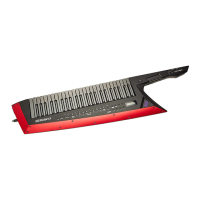
